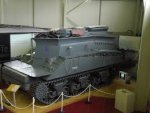The original BARV was a
Sherman M4A2 tank which had been waterproofed and had the turret replaced by a tall armoured superstructure. Around 60 were deployed on the invasion beaches during the
Battle of Normandy. Able to operate in 9-foot (2.7 metre) deep water, the BARV was used to remove vehicles that had become broken-down or swamped in the surf and were blocking access to the beaches. They were also used to re-float small
landing craft that had become stuck on the beach. Unusually for a tank, the crew included a
diver whose job was to attach towing chains to stuck vehicles.
The vehicles were developed and operated by the
Royal Electrical and Mechanical Engineers. The Sherman M4A2 model was chosen as a basis for the BARV as it was thought that the Sherman's welded hull would be easier to waterproof than other tanks. Unlike other Sherman models, the M4A2 was powered by a
diesel engine because it was believed the tank would be less affected by the sudden temperature changes caused by the regular plunges into cold water.
A few Sherman BARV's continued to be used until 1963, when they were replaced by a vehicle based on the
Centurion tank.



